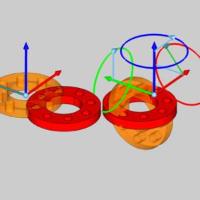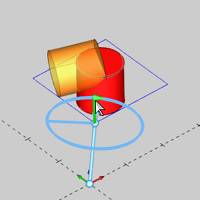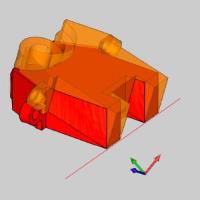 Rotate 3D
Rotate 3D
Introduction
This topic will explain the Rotate 3D function, and the options found in it. This topic will also give brief description of Dynamic Drawing, the Snap Increment function, will describe where to find the function, provide quick steps on how to use it, and provide links to related topics.
The Rotate 3D Function
The Rotate 3D function rotates geometry around any axis (user-defined line), with an optional copy, using Dynamic Drawing. Dynamic Drawing allows you to use data entry or sketch handles to define the start and end of the rotation axis and the rotation angle. The benefit of Dynamic Drawing is that both methods can be utilized at any time during creation. You can use the sketch handles to get close to the desired result and then update the Data Entry parameters to get the exact value.



Dynamic Drawing
This function supports Dynamic Drawing which allows you to use a combination of sketching and data entry to create the entities. Prior to confirming the desired result in the function, an adjustable preview is visible. These previews can be modified using the sketch handles, data entry, or a combination of both. The benefit of Dynamic Drawing is that you can quickly utilized the sketch handles to adjust the size, placement, and, or, orientation to get the approximate result, and then use data entry to update to the exact values as needed.
|
Preview with Sketch Handles |
Final Entities |

|

|
In the images above, we see the preview of the altered position / orientation of the entities which can be adjust with sketch handles, followed by those same entities after their positions / orientations are finalized.
Snap Increment
This function support the use of the snap increment when selecting the location of the entities. The snap increment allows you to get precise results when using mouse selection and helps to reduce data entry modifications.
To learn more, view Snap Increment.
Navigation
To open Rotate 3D:
- In the Move group, of he Utilities ribbon,
click the down arrow under
 Rotate, and select
Rotate, and select  Rotate 3D.
Rotate 3D.
The parameters display in the Data Entry Manager.
The Data Entry Parameters
 Type
Type
-
 Rotate
Rotate -
 Rotate 3D
Rotate 3D
Selected Geometry
|
|
|
| The list box will list the entities currently selected for the function. | |
Angle Around Axis
- Rotation Angle - The Angle parameter determines the amount of rotation, in degrees, around the defined rotation axis. Dynamic Drawing allows you to set the angle using sketch handles, data entry, or a combination of both. When using sketch handles, the snap increment applies.



Tip: The Rotation Angle sketch handle points in the positive direction of rotation based on the right-hand rule.
Note: When rotating solids, a Rotate feature is added to the CAD Tree.
Rotation Axis
-
 Pick Axis - the axis will be defined manually, with an existing axis, or a defined vector.
Pick Axis - the axis will be defined manually, with an existing axis, or a defined vector.  Pick Axis - the axis will be defined by selecting a line, or surface edge.
Pick Axis - the axis will be defined by selecting a line, or surface edge.
The following parameters vary depending on the Pick Axis option that is chosen:
![]() Pick Axis
Pick Axis
- Along X Axis - sets the X axis as the axis to rotate around.
- Along Y Axis - sets the Y axis as the axis to rotate around.
- Along Z Axis - sets the Z axis as the axis to rotate around.
- Customized Axis - allows for a custom axis to used for the axis of rotation.
![]() Pick Axis
Pick Axis
Rotation Axis
|
|
|
| The list box will list the entity currently selected for the function. | |
Note: The direction defines the vector of the rotation. The direction values are always visible, but can only be edited when Pick Axis is not selected, and the Customized Axis option is chosen. When it is, type in the desired values in the X, Y, Z boxes to define the direction from the Origin Point.
- Origin X - sets the X value for the center of rotation.
- Origin Y - sets the Y value for the center of rotation.
- Origin Z - sets the Z value for the center of rotation.
- Direction X - lists the x value for the vector of the rotational axis.
- Direction Y - lists the y value for the vector of the rotational axis.
- Direction Z - lists the z value for the vector of the rotational axis.
 Options
Options
- Copies - adds the specified amount of copies consecutively to the rotated geometry instead of only rotating the original geometry. When using copy, the original geometry is not rotated.
- Scale - scales the rotated geometry by the amount typed in the Scale box. A value of one equals no scaling and a value of 0.5 means fifty percent of the original size.
- OK - finalizes the function.
- Cancel - exits the function.
Quick Steps - Rotate 3D
- Open the function.
The Selected Geometry list automatically has focus. - Select the geometry to be rotated.
The geometry is added to the Selected Geometry list, and the sketch handle appears. - Define the Rotation Angle, and the Rotation Axis.
The preview updates. - With the preview showing the desired result, click OK.
Note: When this feature is applied to solids, or surfaces, a CAD feature is added to the CAD Tree.
- Repeat as necessary.
Tip: Instead of applying features to solids and surfaces more than once, go to the CAD Tree to edit the existing feature. Since all solid and surface moves, and modifications are stored in the CAD Tree, editing a feature is preferable to adding many more to achieve the desired result. This will keep file size down and help ensure files don't become slow to respond.
-
Click Cancel to close the function.
 (Delete All)
- removes all entities from the list.
(Delete All)
- removes all entities from the list.

